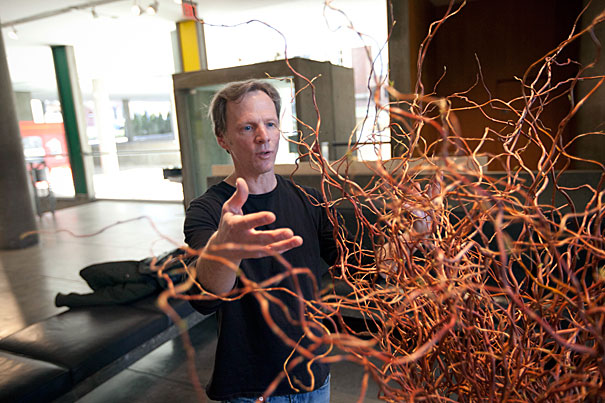
As the center’s exhibitions manager, Ed Lloyd has the job of reconfiguring the building’s 2,500-square-foot Main Gallery (as well as its smaller Sert Gallery) up to six times a year to suit the ideas, aesthetics, and whims of the artists whose work is shown there.
Kris Snibbe/Harvard Staff Photographer
If he builds it, the artists come
Exhibitions manager Lloyd brings art to life at Carpenter Center
The Carpenter Center for the Visual Arts is one of the most famous buildings at Harvard. And like many important structures, Le Corbusier’s only North American masterpiece has been preserved down to the smallest of details — the patina of the concrete floors, the bold primary colors of accent walls.
But to Ed Lloyd, the Carpenter Center’s first-floor entry hall is a blank slate, ready to be wiped clean and reimagined every other month. As the center’s exhibitions manager, Lloyd has the job of reconfiguring the building’s 2,500-square-foot Main Gallery (as well as its smaller Sert Gallery) up to six times a year to suit the ideas, aesthetics, and whims of the artists whose work is shown there.
“It’s a beautiful room,” Lloyd said one afternoon, relaxing in front of “Hellos and Goodbyes,” a series of prints of waving hands that is part of the gallery’s latest exhibition, “Annette Lemieux: Unfinished Business.” But there’s always a caveat: ????You have to compromise.”
Because nothing can be permanently altered in the glass-and-concrete space, Lloyd starts fresh with each exhibition, right down to constructing the white walls. In every case, his goal is to bring artists’ work to life despite any constraints. He’s equal parts handyman, designer, organizer, negotiator, and visionary.
The job lends itself to extremes, as when performance artist and provocateur William Pope.L staged “Corbu Pops” at the Center in 2009. The frenetic show involved turning a bench into a puppet stage, shooting a video piece, creating theater lighting, hiring a New Jersey sculptor to create models, coordinating rehearsals of a student performance, and locating five gallons of Vaseline to cover a large table in the middle of the room. (Why the petroleum jelly? “You’d have to speak to the artist about that,” Lloyd demurred.)
Other times, Lloyd does more tearing down than building. For a 2007 Félix González-Torres exhibition, he cleared out the normally austere Main Gallery and covered the floor with 2,500 pounds of foil-wrapped candies, filling the room with a glittering, golden glow.
“It was really elegant and beautiful and simple,” Lloyd said.
People skills are critical. On any given day, Lloyd interacts with artists, curators, assistants, trade workers, and movers, a mix of the scholarly, the free-spirited, and the blue collar. Most important, he must build trust with the artists in each show.
“It’s important that the artist communicates to you what they want and that they believe you can execute it,” he said. “Once an artist is comfortable with you and you have that dialogue, you can make decisions without having to check in constantly. But you have to build that relationship.”
He prefers to design in his head first, sketching later on floor plans, and never relying on models, which can create a false sense of the space.
“I know how the room works and what it lends itself to,” he said. “It’s just like making a painting or a sculpture. You start with that same aesthetic process.”
Lloyd grew up in Saratoga Springs, N.Y. As a boy, he was drawn to Skidmore College’s art gallery. He moved to Boston in the 1980s to attend the School of the Museum of Fine Arts and slowly worked toward a degree in painting, taking part-time jobs in galleries, artists’ studios, and the school’s exhibition department to pay his bills.
“I always needed to work, so anything I could do to stay within a gallery or the arts was a plus,” he said. After graduating in 1990, he eventually became exhibitions manager at the Museum School’s Grossman Gallery, where he stayed for 12 years. He came to the Carpenter Center in 2005.
He shares his South End home with his wife, a curator. Being married to a fellow art professional helps keep him sane and inspired in his work.
“I can go home with problems, and they can be understood,” he said.
When he’s not working, Lloyd spends a lot of time outdoors, in part to counteract the mental strain of staring at the same two rooms for a living: “Everywhere, white walls,” he joked. He also golfs — an admittedly unlikely hobby — at Boston’s public courses, where he can avoid the “golf carts and cigars and plaid-pants” crowd.
Of course, Lloyd also sees other shows, but he often finds it difficult to quiet his internal exhibitions manager.
“The design becomes my nemesis for enjoying the art,” he said with a laugh. At other galleries and museums, he often finds himself scrutinizing “not the show itself, but the process of how it got there, and how and why it was decided.”
If he and his team are doing their job well, Lloyd said, their work shouldn’t be noticed at all. It’s the perfect job for a modest guy who eschews the spotlight. “When a show is perfectly done, perfectly designed,” he said, “the work that I do is not there. You don’t see it.”




